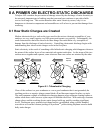
Teledyne API M701H High Performance Zero Air Generator A Primer on Electro-Static Discharge
06712B (DCN5875) 8-3
Potentially damaging electro-static discharges can occur:
Any time a charged surface (including the human body) discharges to a device. Even simple
contact of a finger to the leads of a sensitive device or assembly can allow enough discharge to
cause damage. A similar discharge can occur from a charged conductive object, such as a metallic
tool or fixture.
When static charges accumulated on a sensitive device discharges from the device to another
surface such as packaging materials, work surfaces, machine surfaces or other device. In some
cases, charged device discharges can be the most destructive.
A typical example of this is the simple act of installing an electronic assembly into the connector
or wiring harness of the equipment in which it is to function. If the assembly is carrying a static
charge, as it is connected to ground a discharge will occur.
Whenever a sensitive device is moved into the field of an existing electro-static field, a charge may
be induced on the device in effect discharging the field onto the device. If the device is then
momentarily grounded while within the electrostatic field or removed from the region of the
electrostatic field and grounded somewhere else, a second discharge will occur as the charge is
transferred from the device to ground.
8.3 Common Myths About ESD Damage
I didn’t feel a shock so there was no electro-static discharge: The human nervous system isn’t
able to feel a static discharge of less than 3500 volts. Most devices are damaged by discharge
levels much lower than that.
I didn’t touch it so there was no electro-static discharge: Electro-static charges are fields whose
lines of force can extend several inches or sometimes even feet away from the surface bearing the
charge.
It still works so there was no damage: Sometimes the damaged caused by electro-static discharge
can completely sever a circuit trace causing the device to fail immediately. More likely, the trace
will be only partially occluded by the damage causing degraded performance of the device or
worse, weakening the trace. This weakened circuit may seem to function fine for a short time, but
even the very low voltage and current levels of the device’s normal operating levels will eat away
at the defect over time causing the device to fail well before its designed lifetime is reached.
These latent failures are often the most costly since the failure of the equipment in which the
damaged device is installed causes down time, lost data, lost productivity, as well as possible
failure and damage to other pieces of equipment or property.
Static Charges can’t build up on a conductive surface: There are two errors in this statement.
Conductive devices can build static charges if they are not grounded. The charge will be
equalized across the entire device, but without access to earth ground, they are still trapped and
can still build to high enough levels to cause damage when they are discharged.
A charge can be induced onto the conductive surface and/or discharge triggered in the presence
of a charged field such as a large static charge clinging to the surface of a nylon jacket of
someone walking up to a workbench.


















